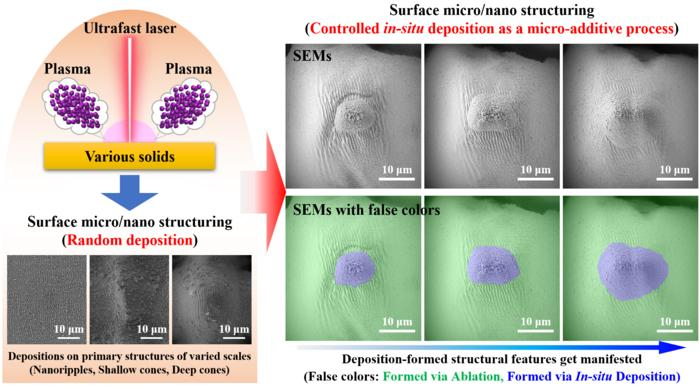In addition to becoming a field of study motivated by bionics, surface functionalization by micro/nanostructuring is crucial for several real-world applications. The creation of surface micro/nano structures with regulated dimensions, hierarchies, and compositions is essential for accomplishing a variety of surface functions and is fueling the ongoing advancement of micro/nanofabrication techniques.

Controlled in-situ deposition opens new possibilities in ultrafast laser surface micro/nano structuring. Image Credit: Peixun Fan, Guochen Jiang, Xinyu Hu, Lizhong Wang, Hongjun Zhang, Minlin Zhong
Tsinghua University in China’s School of Materials Science and Engineering has a Laser Materials Processing Research Center where researchers have been working for years to develop laser-enabled fabrication techniques for surface micro/nanostructure preparation and functional application exploration.
The ability to independently and precisely manipulate the micro- and nanoscale characteristics, as well as how they interact to produce various multi-level structures, has been demonstrated by the researchers.
Extreme wettability, anti-icing, broadband light absorption, structural colors, solar water evaporation, thermal interface management, tribological properties, surface-enhanced Raman spectroscopy, photoelectrocatalysis for energy applications, and other features and applications have all been researched.
One of the ongoing research goals is to use ultrafast lasers to gain better control over the construction of structures and to develop more flexible manufacturing techniques.
Researchers have recently shown that the in-situ deposition of particles after ultrafast laser ablation of solid surfaces can be controlled and utilized as a localized micro-additive process to pile up hierarchical surface structures, in addition to managing the ultrafast laser ablation process. When solids are ablated with pulsed lasers, a ubiquitous phenomenon known as plasma plume production occurs.
When using external liquids (for example, in laser ablation in liquids) or substrates (for example, in pulsed laser deposition), the products (such as nanoparticles) from the plasma plumes can be collected. On the other hand, during ultrafast laser surface structuring, a portion of the nanoparticles from the plasma plumes in-situ return to the irradiated surfaces.
The in-situ deposited structural elements are important for improving surface characteristics such as energy conversion, light absorption, and sensitivity for certain applications. It is yet unclear, though, whether and how the in-situ deposition process can be managed.
Recent studies have demonstrated the capacity to manipulate the in-situ deposition process, for example, to construct fort-like structures rather than merely generate randomly distributed nanoparticles on top of micro cone arrays. The mechanism of laser-matter interaction that has been described can spur future research efforts to investigate novel avenues for fabricating functional surface micro/nanostructures through the use of ultrafast lasers.
Journal Reference
Fan, P., et al. (2023) Localized in-situ deposition: a new dimension to control in fabricating surface micro/nano structures via ultrafast laser ablation. Frontiers of Optoelectronics. doi:10.1007/s12200-023-00092-1